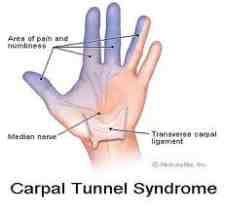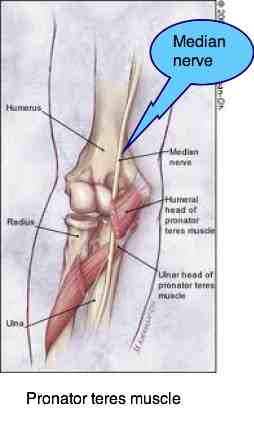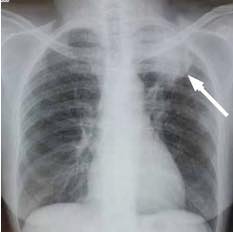- Home
- Tingling arms
- Severe pain radiating down lower arm to fingers
Severe pain radiating down lower arm to fingers
Pronator teres syndrome

Severe pain radiating down lower arm to fingers especially at night is a common complaint at the chiropractic coalface. The pronator teres syndrome is one of the common causes; carpal tunnel is the other.
The critical point is which fingers are affected, and what provokes and relieves the pain?
The radiation is often vague, but it helps your chiropractor if you can tell him which fingers are tingling and numb, and if any are definitely not affected.
For example, if the pinkie is involved, then it's definitely not the median nerve that is affected, and it can't be a carpal tunnel problem; nor the pronator teres syndrome.
There are numerous sites from the neck to the fingers where a nerve can be trapped, and not just in the wrist.
The median nerve can be irritated in the
- inter scalene triangle,
- under the tendon of the pectoralis minor muscle,
- in the vice between the bellies of the pronator teres muscles,
- and in the carpal tunnel.
Moreover, many authorities have written how a degenerate uncovertebral joint in the neck can cause typical median nerve type symptoms.
Severe pain radiating down lower arm to fingers
Severe pain radiating down lower arm to fingers excluding the pinkie makes one consider carpal tunnel and pronator teres syndrome.
If the pain is relieved when the limb is raised above the head, taking the tension off the median nerve, then we think of a pinched root in the cervical spine. Known as the shoulder abduction relief sign, you will find that sleeping with your hand under your pillow brings a measure of relief from the severe ache radiating down lower arm to fingers.
Conversely stretching out the arm, as in carrying heavy parcels will increase the pain and tingling in the fingers. The upper limb tension test will be positive; more about that lower down.
In addition, rotation of the head and neck to the same side, and particularly if you then look up, will provoke discomfort in the lower cervical spine and increase the severe pain radiating down the lower arm to the fingers.
However, in some of these severe pain radiating down the lower arm to the fingers syndromes there is no apparent cervical spine problem other than stiffness perhaps, and movements of the neck do not provoke the symptoms.
If raising the offending arm above the head increases the pain, then we think of a thoracic outlet syndrome, where the plexus of nerves and the artery to the arm are affected in the inter scalene triangle, just below the neck. The usual cause is a first rib subluxation. The so called Adson's test will be positive; turning the cervical spine to the same side, looking up and taking in a deep breath obliterates the radial pulse.
Or, a pectoralis minor syndrome, where these same structures are affected by its tendon as the limb is raised above the head; again tingling in the hand, numbness, weakness and a deep ache in the arm are typical.
To complicate matters further, the symptoms can be mainly due to stretching of the brachial plexus of the nerves, or of either the artery or vein, giving different, but overlapping patterns of ache and tingling.
Drawing the shoulder down, and extending the arm in various ways obliterates the pulse in the wrist.
Then the median nerve passes between the two bellies of the pronator teres muscle in the forearm where it may be trapped, again causing severe pain radiating down the lower arm to the fingers, but excluding the pinkie.
In short it mimics the carpal tunnel syndrome but there are no symptoms in the wrist and direct pressure on the muscle reproduces the symptoms.
And lastly, there's the well known impingement in the carpal tunnel in the wrist causing the same symptoms, but always excluding the little finger. In that case you are probably looking at a nerve impingement in the spine itself; but again the lowermost trunk of the brachial plexus, carrying the C8 fibres, lies on the offending first rib. A thoracic outlet syndrome also affects the pinkie, but with a positive Adson's test. It's complex.
Pronator teres syndrome case file
Pronator teres syndrome mimics carpal tunnel as they both affect the median nerve causing severe pain radiating down the lower arm to the fingers; the pinkie is always excluded.

Mister X is a forty year old solar technician; working with arms is part of the job, often above his head, and often simultaneously looking up. He had a whiplash many years previously which has caused some deterioration of the uncovertebral joint of Luschka; however he has no neck pain and movements of his head and neck do not provoke the severe pain radiating down lower arm to fingers.
He used a heavy hammer drill to make a large hole in a brick wall which started the painful ache in his lower arm and tingling in the fingers. He wasn't sure exactly which fingers, but it definitely wasn't in the pinkie and was predominantly in the thumb area.
The pain had started some two months previously and was especially bad in the early hours of the morning, again mimicking carpal tunnel syndrome.
Movements of his head and neck did not affect the radial pulse in the forearm, Adson's test is negative. But drawing the shoulder down and the arm backwards in the so called costo clavicular manoeuvre did obliterate the pulse: it appeared the pectoralis minor tendon was involved. However there was absolutely no pain or tenderness in the chest wall below the collarbone, or in the armpit.
Deep pressure over the pronator teres muscle immediately provoked the severe pain radiating down the lower arm to the fingers.
Tingling in hands and arms
Tingling in hands and arms is always one of the major symptoms; not wishing to be boring, with so much repetition, but it's so often missed: it always excludes the little finger, and is usually unilateral, but certainly can occur in both arms.
To summarise, Mr X has
- Severe pain radiating down lower arm to fingers, thumb to ? ring finger, especially driving the car and in the early hours.
- Mild lower cervical spine deterioration.
- A negative Adson's test ruling out the thoracic outlet syndrome.
- A positive costoclavicular manoeuvre but no symptoms around the pectoralis minor tendon or muscle.
- Increased pain when working above his head.
- Immediate pain reproducing his symptoms when pressure is placed on the pronator teres muscle.
- No actual loss of sensation, weakness or changes in reflexes.
- A negative upper limb tension test.
Chiropractic help
Chiropractic help seeks to address the cause of the symptoms, and not the symptoms themselves.
Happily, Mr X responded well to the usual regimen of adjusting the lower cervical spine, and deep active release of the pronator teres muscle; within four treatments he was pain free.
Heavy work with his arms such as using a hammer, or hoeing in the garden could again provoke the severe pain radiating down arm to the fingers; interestingly a piece of duct tape across the palm of the hand also helps.
Progress
For two years Mr X had no problems with his arm. Then he purchased a piece of land, started building a home, and using a heavy hoe to clear the land.
Within weeks the deep ache down his right lower arm and spreading into his fingers started wakening him again in the early hours of the morning. Again driving the car provoked the symptoms, and he had to let his wife drive whenever possible.
Again the symptoms mimic the carpal tunnel syndrome, but without any sign of problems in the wrist.
The tests are similar to the first event two years previously. I wonder if he will respond as quickly again.
He lives two hours away; I'm the nearest chiropractor. One month later he emailed: "My arm is doing well, will talk to you about it when I am coming past there again." I've just ordered a second MPPT so that we can increase our solar power. He will deliver it. You could have a solar generator too. It's not rocket science.
Comment
These arm pain syndromes are complex, and there are many overlapping signs and symptoms; it takes the diligent diagnostician to work out what is the real spoke in the wheel.
Often there is either lower cervical degeneration in the uncovertebral Luschka joints, or a first rib fixation; sometimes the radial pulse is obliterated by movements of the head, with breathing, and other times by the position of the arm.
The nerve tension tests may or may not be positive; there may be actual weakness and numbness but not necessarily so in the early days.
But always there the deep ache, tingling and often a numb feeling in the arm, and varying fingers; try and identify the region affected as accurately as you can, and the movements that provoke the pain before you consult your chiropractor.
Very occasionally, if you're a smoker and have a bad cough, we would have to consider a Pancoast tumour in the apex of the lung. That too causes pain and tingling in the hand and arm as the tumour impinges on the nerves coursing their way from the lower neck, through the armpit on the way to the fingers.

And sometimes it's really just a rotator cuff syndrome; a pulled muscle in the shoulder. Active trigger points from the shoulder can radiate down the arm.
In short, take severe pain radiating down arm to fingers seriously. It can bite you.
Useful links
- Go from severe pain radiating down lower arm to fingers to carpal tunnel syndrome.
- Arm pain quick DASH score helps your chiropractor.
- Home
- Tingling arms
- Severe pain radiating down lower arm to fingers
Did you find this page useful? Then perhaps forward it to a suffering friend. Better still, Tweet or Face Book it.
